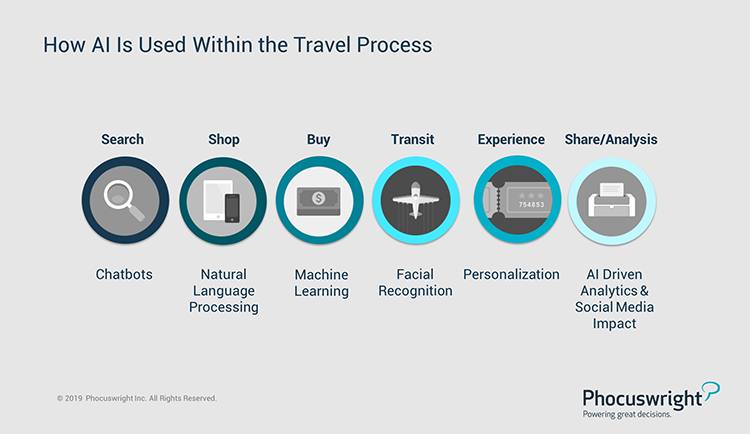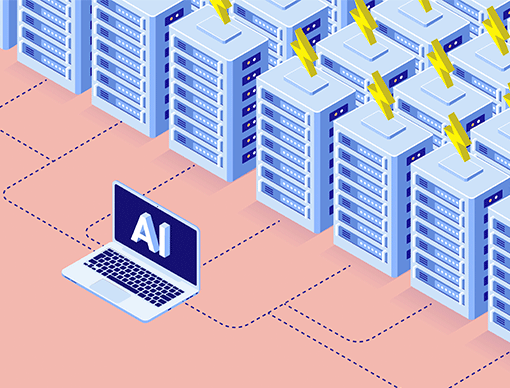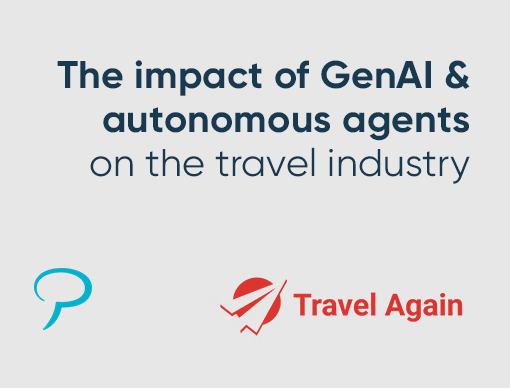AI and the travel life cycle
- Published:
- April 2019
- Analyst:
- Phocuswright Research
Today, AI is touching the traveler directly and powering advanced analytics in back-end travel processes. Here's a look at some of the applications and challenges along the traveler life cycle from Phocuswright's latest travel research report, AI: Has Its Time Come or Are We Headed to the Trough of Disillusionment?
Search, Shop and Buy
Chatbots were all the rage in 2017 and interactive voice, especially with the growth of digital assistants, reached the top of the hype cycle in 2018. Many expected chatbots and voice to become the dominant form of travel search and shop, through platforms such as Slack or Facebook as the next interface for travel transactions. Most successful implementations of chatbots have been on the customer service end of the passenger interaction spectrum. Voice has proven useful for simple tasks such as flight status requests, but so far fails to provide a full end-to-end booking environment.
Machine Learning, one of the most popular uses of AI, is impacting the search, shop and buy process through the potential to deliver more customized products and services to travelers. The challenge with Machine Learning is the huge amount of data needed to enable the machine to learn the patterns of the individual or subsegment. Even when a vast amount of data is available, the infrequency of leisure travelers and the differing personas of the business traveler may inhibit the effective use of Machine Learning for personalization.
Transit
In addition to the use of Machine Learning and voice deployed to improve the experience, the most promising AI technology is the use of facial recognition. A number of airlines are using facial recognition to replace the current boarding pass scanning process, by simply using face recognition to verify that you are you.
In-Destination
The Internet of Things (IoT) has resulted in thousands of sensors being deployed throughout cities or specific destinations. AI helps gather and analyze data from IoT devices (such as beacons) to measure crowd flow, and to trigger opt-in messages to travelers.
Autonomous vehicles, though overhyped, are starting to appear at travel destinations, not necessarily in the form of self-driving cars, but rather dedicated autonomous vehicles for transport between pre-determined end points as described in Phocuswright's
recent study.
Analysis
The term 'predictive analysis' has its roots in AI. The ability to use vast amounts of data to predict and anticipate the behavior of the traveler is one of the most promising applications of AI within the travel industry. This data may be used internally for measurement and reporting or may actually drive services to the end traveler.
AI use for analytics is not limited to predicting behavior, as AI Machine Learning techniques are being used in a large variety of applications such as enabling a 100% audit of expense reports identifying fraud. Of course, Machine Learning accuracy is dependent on the accuracy of the underlying data.
This article is part of a
content series that explores some of the most significant technology-driven issues or developments that will shape travel distribution this year and beyond. For more on these hot topics – and to unlock every Phocuswright report, chart and data set for your entire company – explore the
Open Access research subscription.
Join Phocuswright in its groundbreaking study that quantifies, qualifies and compares the use of technology by travelers from 7 countries (China, France, Germany, Indonesia, Japan, the U.K. and U.S.) during the entire trip life cycle.
CLICK HERE to lean more about this Phocuswright Special Project.
Travel Tech and Innovation at Phocuswright Europe
Join us at Phocuswright Europe (May 15-16 in Amsterdam) to explore the latest in the region's tech scene. Highlights include:
- Battleground and Launch innovator competitions (companies to be listed soon!)
- Executive Roundtable: Tech Heads
- Tech Talk: SITA
- Tech Talk: Google
- View the full program













